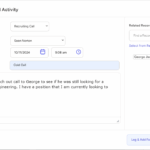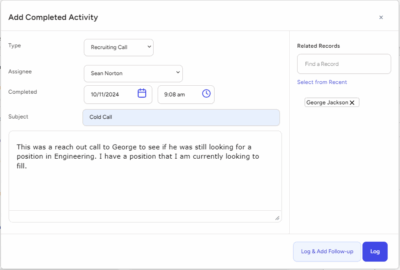Agency recruiters and search consultants are continually challenged to navigate a complex landscape while striving to deliver exceptional results. Amidst this backdrop, technology emerges as a vital ally, offering tools and solutions to streamline recruitment processes and boost productivity. At the heart of these technological advancements lies the applicant tracking system (ATS), a cornerstone platform designed to manage candidate workflows and facilitate seamless communication.
However, the true power of an ATS lies not just in its features but in how effectively it harnesses automation, particularly in terms of data entry. In this blog post, we shall explore the significance of automated data entry within an ATS and its transformative impact on recruitment efficiency, accuracy, and overall success for agency recruiters and search consultants.
Understanding the Essence of Automated Data Entry
Automated data entry in an Applicant Tracking System revolutionizes the way recruiters manage and process candidate information. It involves the seamless extraction and input of data from various sources, such as resumes, emails, and online forms, directly into the ATS database.
By leveraging advanced technologies such as Optical Character Recognition (OCR), Natural Language Processing (NLP), and Application Programming Interfaces (APIs), recruiters can eliminate the need for manual data entry, thereby saving time, reducing errors, and enhancing the overall efficiency of the recruitment process.
Exploring Key Benefits of Automated Data Entry
There are many key benefits of automated data entry in an ATS platform. In fact, we’ve listed 16 such benefits below.
Without further adieu, let us peruse them . . .
Time Savings and Efficiency
Manual data entry is notorious for its time-consuming nature, often diverting recruiters’ attention away from strategic activities. Automated data entry alleviates this burden by swiftly processing and inputting information into the ATS database. As a result, recruiters can redirect their focus towards sourcing top talent, nurturing client relationships, and driving business growth, ultimately leading to faster time-to-fill rates and heightened productivity.
Resume Parsing Excellence
Automated resume parsing tools excel at extracting pertinent information from resumes, such as contact details, work experience, and skills, and seamlessly populating the corresponding fields in the ATS. This eliminates the arduous task of manually entering candidate data, significantly reducing administrative overhead and accelerating the recruitment process.
Streamlined Email Integration
Integrating email functionalities into the ATS enables automatic capture and storage of email communications between recruiters and candidates. By centralizing communication history within the system, recruiters can access relevant correspondence promptly, enhancing candidate management and communication efficiency.
Seamless Form Autofill Capabilities
Automated data entry extends to online forms and applications, where candidates’ information can be automatically populated from the ATS database. This streamlines the application process, reducing friction for candidates and ensuring a seamless experience from start to finish.
Accuracy and Consistency
The integrity of recruitment data is paramount to informed decision-making and effective talent acquisition strategies. Manual data entry is susceptible to errors, such as typos, misspellings, and formatting inconsistencies, which can compromise data accuracy and reliability. Automated data entry mitigates this risk by extracting information directly from source documents and inputting it into the ATS database with precision and consistency.
Harnessing Optical Character Recognition (OCR) Technology
OCR technology plays a pivotal role in automated data entry by converting scanned documents, such as resumes and cover letters, into editable text. This enables the ATS to interpret and process textual information accurately, even from non-editable formats, ensuring that no valuable data is lost in translation.
Leveraging Natural Language Processing (NLP) Algorithms
NLP algorithms analyze and interpret text data, enabling the ATS to extract relevant information from job descriptions, resumes, and other textual sources automatically. By understanding the context and semantics of the content, NLP ensures that data entry is not only accurate but also structured consistently, enhancing data integrity across the board.
Enforcing Data Validation Rules
Automated data entry systems can enforce data validation rules to ensure that only valid and accurate information is entered into the ATS database. By flagging errors, inconsistencies, and outliers in real-time, these rules uphold data quality standards and facilitate compliance with organizational protocols and industry regulations.
Improved Candidate Experience
The candidate experience plays a pivotal role in shaping an organization’s employer brand and attracting top talent. Manual data entry can introduce friction and delays into the application process, detracting from the overall candidate experience. Automated data entry streamlines the process, enabling candidates to submit their information seamlessly and efficiently, thereby enhancing their perception of the organization.
Reducing Friction with Seamless Automation
Automated data entry removes barriers in the application process, allowing candidates to submit their resumes and other documents without encountering cumbersome manual entry requirements. This frictionless experience demonstrates professionalism and efficiency, leaving a positive impression on candidates and reinforcing the organization’s commitment to a seamless candidate journey.
Enhancing Communication Efficiency
By centralizing communication history within the ATS, recruiters can respond to candidate inquiries promptly and provide timely updates on their application status. This transparency and responsiveness contribute to a positive candidate experience, fostering goodwill and engagement with the organization.
Demonstrating Technological Sophistication
Implementing automated data entry capabilities showcases the organization’s commitment to leveraging technology to enhance efficiency and innovation. Candidates are more likely to view technologically advanced organizations favorably, associating them with professionalism, reliability, and forward-thinking practices.
Enhanced Compliance and Security
Compliance with data protection regulations is paramount for safeguarding candidate privacy and mitigating the risk of data breaches. Manual data entry introduces vulnerabilities that can compromise data security and regulatory compliance. Automated data entry systems implement robust security measures and data validation protocols to ensure that recruitment data is handled securely and in accordance with regulatory requirements.
Mitigating Risks with Encryption and Access Controls
Automated data entry systems employ encryption protocols and access controls to safeguard sensitive recruitment data from unauthorized access or breaches. By encrypting data at rest and in transit and enforcing granular access permissions, these systems minimize the risk of data exposure and ensure compliance with data protection regulations.
Upholding Compliance with Data Retention Policies
Automated data entry systems can enforce data retention policies to ensure that recruitment data is retained for the appropriate duration and disposed of securely when no longer needed. By automating data lifecycle management processes, these systems facilitate compliance with data protection regulations and reduce the organization’s exposure to legal and regulatory risks.
The Transformative Impact of Automated Data Entry
Automated data entry has a transformative impact on recruitment operations and outcomes, revolutionizing the way recruiters manage candidate information and execute talent acquisition strategies. By streamlining data entry tasks and enhancing data accuracy, automated data entry empowers recruiters to work more efficiently, make informed decisions, and deliver exceptional results for clients and candidates alike.
1. Time Efficiency and Resource Optimization
Automated data entry frees recruiters from the drudgery of manual data entry, enabling them to allocate their time and resources more effectively. By automating repetitive tasks and processes, recruiters can focus on high-value activities that drive business growth, such as sourcing top talent, nurturing client relationships, and expanding their talent networks.
Empowering Recruiters with Time Savings: The time saved through automated data entry translates into tangible benefits for recruiters, allowing them to handle larger volumes of requisitions and manage multiple workflows simultaneously. This increased efficiency enhances recruiters’ capacity to meet hiring demands promptly and deliver exceptional results for clients and candidates.
Optimizing Resource Allocation: Automated data entry optimizes resource allocation by reallocating manpower from mundane administrative tasks to strategic activities that add value to the recruitment process. Recruiters can leverage automation to scale their operations, handle peak hiring periods efficiently, and respond promptly to changing business needs without compromising on quality or accuracy.
2. Data Accuracy and Reliability
The accuracy and reliability of recruitment data are critical to informed decision-making and effective talent acquisition strategies. Manual data entry introduces errors and inconsistencies that can undermine the integrity of recruitment data. Automated data entry systems enhance data accuracy by extracting information directly from source documents and enforcing validation rules to ensure data quality and consistency.
Elevating Data Integrity with Automated Extraction: Automated data entry systems leverage advanced technologies such as OCR and NLP to extract information from source documents accurately and efficiently. By automating data extraction processes, these systems minimize the risk of errors and discrepancies that can arise from manual data entry, ensuring that recruitment data is accurate, reliable, and up-to-date.
Enforcing Data Validation Rules and Protocols: Automated data entry systems enforce data validation rules and protocols to ensure that only valid and accurate information is entered into the ATS database. By flagging errors, inconsistencies, and outliers in real-time, these systems uphold data quality standards and facilitate compliance with organizational protocols and industry regulations.
3. Scalability and Flexibility
Automated data entry enables recruiters to scale their recruitment efforts and adapt to changing business needs more effectively. By automating repetitive tasks and processes, recruiters can handle larger volumes of data and manage multiple requisitions simultaneously without sacrificing quality or accuracy. This scalability and flexibility empower recruiters to meet hiring demands promptly and deliver exceptional results for clients and candidates alike.
Accelerating Time-to-Market with Scalable Solutions: Automated data entry solutions enable recruiters to accelerate time-to-market by streamlining data entry tasks and processes. By automating resume parsing, email integration, and form autofill capabilities, recruiters can process candidate information more efficiently, reduce time-to-fill rates, and meet hiring deadlines with ease.
Enhancing Adaptability with Customizable Workflows: Automated data entry systems offer customizable workflow automation capabilities that enable recruiters to tailor data entry processes to their specific needs and preferences. Whether it’s configuring field mappings, setting up automation triggers, or defining approval workflows, recruiters can customize the ATS to align with their unique recruitment processes and requirements.
4. Enhanced Reporting and Analytics Capabilities
Automated data entry facilitates better reporting and analytics by ensuring that recruitment data is accurate, comprehensive, and up-to-date. By centralizing data within the ATS database, recruiters can generate insights, identify trends, and make data-driven decisions to optimize their recruitment strategies and processes.
Real-Time Dashboards for Enhanced Visibility: Real-time dashboards provide recruiters with visibility into key recruitment metrics, such as candidate pipeline status, time-to-fill rates, and source effectiveness. By visualizing recruitment data in real-time, recruiters can monitor performance, track progress, and identify areas for improvement more effectively.
Advanced Analytics for In-Depth Analysis: Advanced analytics tools enable recruiters to conduct in-depth analysis of recruitment data to uncover insights and trends that can inform strategic decision-making. Whether it’s identifying top-performing sourcing channels, analyzing candidate conversion rates, or predicting future hiring needs, recruiters can leverage advanced analytics to gain a competitive edge in talent acquisition.
5. Predictive Modeling for Future Planning
Automated data entry systems enable recruiters to leverage predictive modeling techniques, such as machine learning algorithms, to forecast future hiring trends, identify potential talent gaps, and anticipate recruitment challenges. By analyzing historical data and predicting future outcomes, recruiters can proactively adjust their recruitment strategies and resource allocation to meet business objectives more effectively.
Proactive Talent Acquisition Strategies with Predictive Insights: Predictive modeling techniques enable recruiters to develop proactive talent acquisition strategies based on data-driven insights and forecasts. By identifying emerging trends, predicting future hiring needs, and forecasting talent shortages, recruiters can stay ahead of the curve and align their recruitment efforts with organizational goals and priorities.
Optimizing Resource Allocation with Predictive Analytics: Predictive analytics tools empower recruiters to optimize resource allocation by identifying areas of opportunity and potential risk. By analyzing historical data on candidate engagement, hiring trends, and workforce demographics, recruiters can allocate resources more effectively, streamline operations, and drive better outcomes for clients and candidates alike.
Best Practices for Implementing Automated Data Entry
While the benefits of automated data entry are undeniable, maximizing its effectiveness requires careful planning, implementation, and maintenance. Here are some best practices for implementing automated data entry in an Applicant Tracking System:
Define Data Entry Processes and Protocols: Establish standardized data entry processes and protocols to ensure consistency and accuracy in data entry. Document data entry workflows, field mappings, and validation rules to guide recruiters and ensure compliance with data standards and protocols.
Select the Right Automation Tools and Technologies: Choose automation tools and technologies that align with your recruitment needs and objectives. Consider factors such as scalability, integration capabilities, and ease of use when evaluating automation solutions for data entry.
Provide Comprehensive Training and Support: Offer comprehensive training and ongoing support to recruiters and team members to ensure they understand how to use automated data entry features effectively. Provide training sessions, user guides, and tutorials to help users maximize the benefits of automation.
Monitor Performance Metrics and Compliance: Monitor performance metrics, such as data entry accuracy rates, processing times, and system utilization, to measure the effectiveness of automated data entry. Conduct regular audits and reviews to ensure compliance with data standards and protocols and identify opportunities for improvement.
Continuously Iterate and Improve Processes: Continuously iterate and improve automated data entry processes based on feedback from users and performance metrics. Solicit input from recruiters, stakeholders, and system administrators to identify pain points, address issues, and implement enhancements to optimize data entry efficiency and effectiveness.
Automated data entry is a game-changer for agency recruiters and search consultants seeking to enhance efficiency, accuracy, and scalability in their recruitment efforts. By streamlining data entry tasks and processes, automated data entry empowers recruiters to work more efficiently, make informed decisions, and deliver exceptional results for clients and candidates alike.
From accelerating time-to-market and enhancing data accuracy to enabling predictive insights and proactive talent acquisition strategies, automated data entry has a transformative impact on recruitment operations and outcomes. By adopting best practices and embracing automation, agency recruiters and search consultants can unlock the full potential of their applicant tracking system and achieve greater success in talent acquisition.









